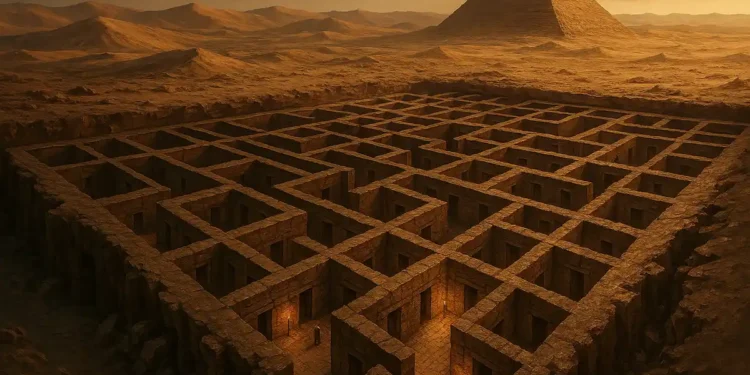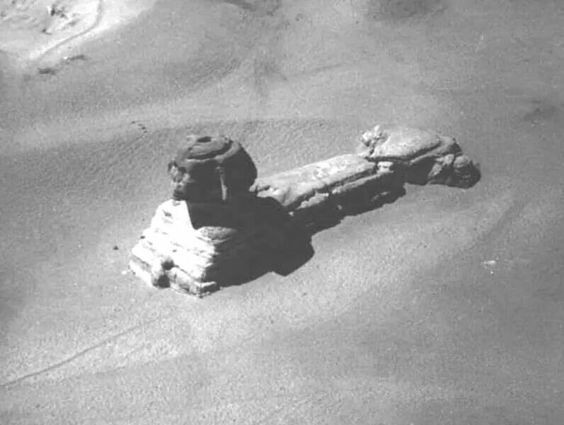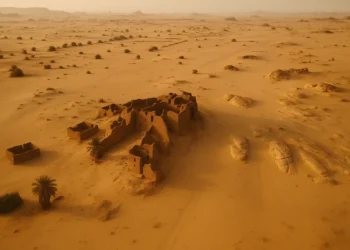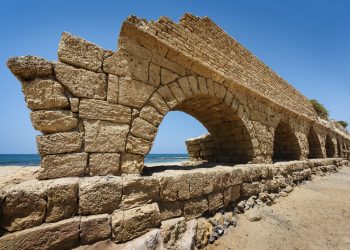There is supposedly a lost labyrinth of ancient Egypt somewhere beneath the golden sands. In the 5th century BCE, Greek historian Herodotus described an enormous underground complex in Egypt that, according to him, “surpassed even the pyramids.” He called it a labyrinth of immense halls, endless rooms, and towering columns — a structure so vast and detailed that it defied belief. For centuries, this so-called lost labyrinth of Egypt has captivated archaeologists, historians, and seekers of ancient secrets. And despite the passage of millennia, some believe it may still lie buried beneath the sands.
What exactly did Herodotus see — and could modern technology finally uncover it? Did he really see a majestic, now lost labyrinth of Egypt?
Herodotus’s Labyrinth: A Monument Greater Than the Pyramids?
In his Histories, Herodotus claimed that he had personally visited the labyrinth near Lake Moeris, in the region now known as the Faiyum Oasis. He described it as a sprawling structure with twelve roofed courts, thousands of rooms split between upper and lower levels, and corridors so confusing that guides were required.
According to his account, the labyrinth was built as a joint burial site for the kings of the 12th Dynasty — possibly during the reign of Amenemhat III, around 1800 BCE. Other ancient writers such as Strabo and Pliny the Elder also referenced the site, repeating similar stories of an awe-inspiring subterranean complex.
Herdodotus wrote: “Though the pyramids beggar description and each one of them is a match for many great monuments built by Greeks, this maze surpasses even the pyramids. [4] It has twelve roofed courts with doors facing each other: six face north and six south, in two continuous lines, all within one outer wall. There are also double sets of chambers, three thousand altogether, fifteen hundred above and the same number under ground.”
Key details from Herodotus’s account include:
-
3,000 chambers, half underground
-
Enormous stone walls and ceilings
-
Sacred crocodile enclosures nearby
-
Proximity to pyramids at Hawara
Yet despite the vivid descriptions, no structure of this scale has ever been conclusively found.
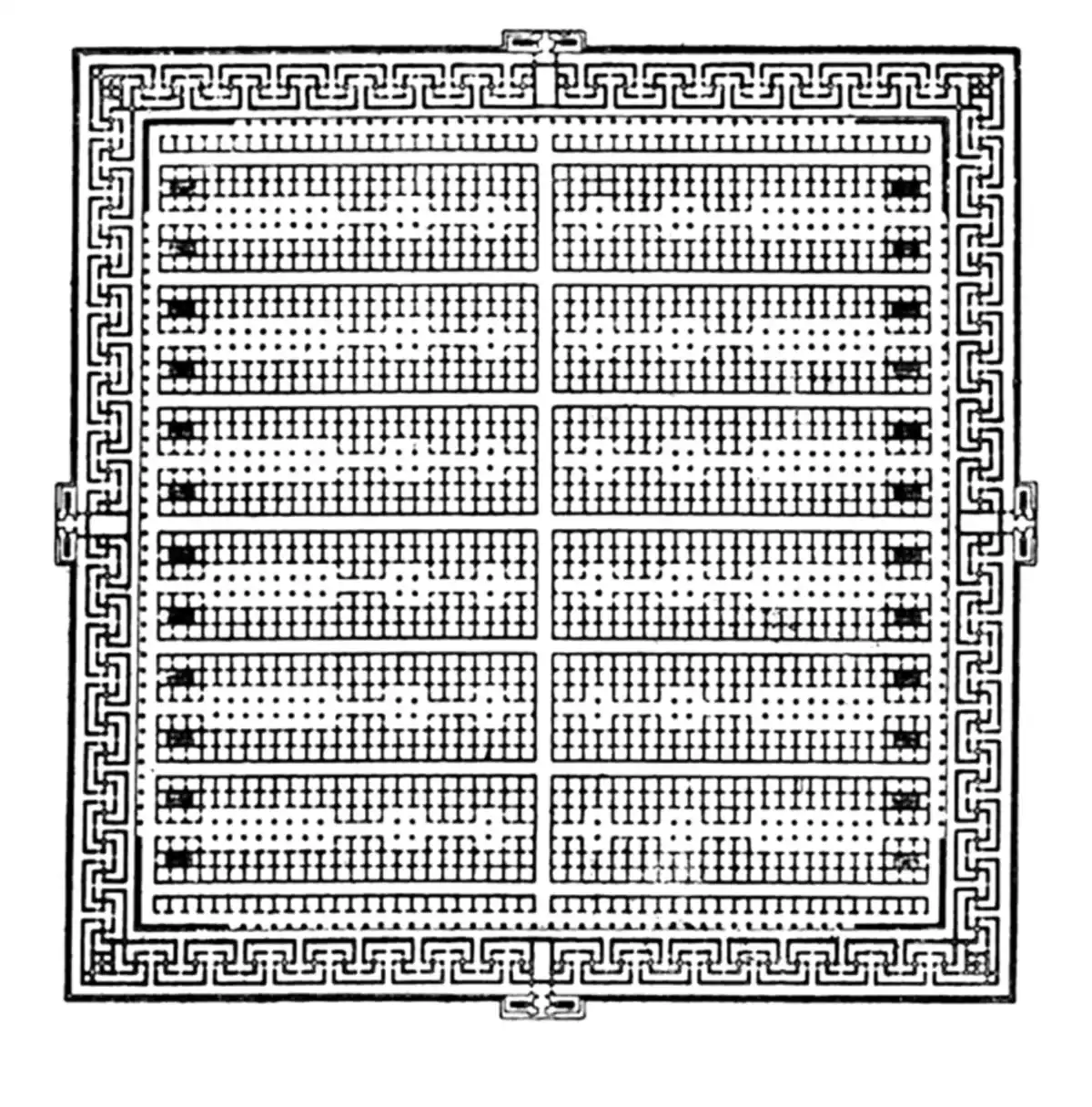
Clues Pointing to Hawara and the Faiyum Depression
Many modern researchers believe that the lost labyrinth of Egypt may have been located near the pyramid of Amenemhat III at Hawara, south of modern Cairo. This site has yielded artifacts and architectural ruins, including large stone blocks and a complex layout that could support Herodotus’s story.
In the 19th century, Sir Flinders Petrie, a pioneering British Egyptologist, excavated the area. He discovered remnants of monumental architecture near Hawara but concluded that the lost labyrinth of Egypt had been dismantled in antiquity, possibly by later rulers scavenging stone.
In recent years, efforts have intensified to examine the site with more advanced methods:
-
In 2008, the Mataha Expedition, supported by the Egyptian Supreme Council of Antiquities and the University of Ghent, conducted a ground-penetrating radar survey of the area near Hawara.
-
Their results showed anomalous subsurface structures beneath the sand — massive rectangular patterns that could represent walls, chambers, or foundations.
The findings were never fully published in mainstream academic channels, and the Egyptian authorities have restricted further access to the area. Many people have actually accused several individuals linked to the ministry of antiquities of Egypt of purposely hiding certain regions or places from research. If the lost labyrinth of Egypt does not exist, then why not let people prove it does not exist? It makes no sense. Does it?
Now… this lack of transparency has only deepened the mystery — and fueled theories that the lost labyrinth of Egypt may still be hiding in plain sight. Is this just a conspiracy theory? A wild chase? Or something entirely else… I guess time will only tell.
Why the Lost Labyrinth of Egypt Still Captures Global Imagination
Unlike many ancient myths, Herodotus’s account is not the only mention of the labyrinth — and that’s what makes it harder to dismiss. Classical authors repeatedly referenced a massive structure in the same region, suggesting it was not a fabrication but perhaps a forgotten casualty of history.
So why hasn’t it been found? Or confirmed? There is evidence of its existence.
Several factors complicate the search for the lost labyrinth of Egypt:
-
The Faiyum region has changed drastically over thousands of years, with flooding, shifting landscapes, and ancient quarrying operations.
-
Politics, restricted funding, and modern development have limited archaeological efforts.
-
The site near Hawara has been looted, damaged, and partly buried under silt from the Nile.
Still, the possibility remains that deeper excavation — or even satellite imaging — could one day confirm the existence of underground structures that match Herodotus’s descriptions.
If the labyrinth truly exists beneath the sands of Egypt, it would be among the greatest archaeological discoveries of all time. Not just because of its size, but because it might contain undisturbed records, hieroglyphs, or tombs from a period of Egyptian history that still holds many gaps.
The legend of the lost labyrinth of Egypt continues to attract archaeologists, fringe theorists, and independent researchers alike — not because it’s a myth, but because it might still be real. And to be honest, if we have learned anything from the past decade of explorations in Egypt, there are many things waiting to be discovered, lying hidden, in silence, for their true beauty to be brought back to the world.



